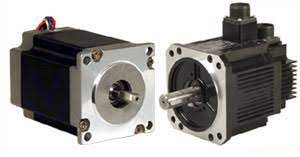
What’s the Difference? – Servo Motor vs Stepper Motor
Motors are among the most widely used Final Control Elements (FCEs) in industrial processes. From pumping and material transfer to actuating fans, conveyors, dampers, and lifting devices, motors are central to automation. With this diversity in application comes a range of control methods, including ON/OFF, speed, torque, and position control. Each method demands specific motor types and control equipment.
For ON/OFF control, magnetic contactors or relays suffice. Speed and torque control typically rely on Variable Frequency Drives (VFDs). But for precise motion and position control, servo motors and stepper motors are preferred.
Let’s explore the critical differences between servo and stepper motors to help clarify their operation and ideal applications.
General Principle of Operation
-
Stepper Motor: Operates in fixed increments or "steps." Most are open-loop systems, meaning there is no feedback to confirm position. Newer stepper motors now offer closed-loop capability with improved torque and performance.
-
Servo Motor: A closed-loop system by default, servo motors receive a stream of pulses from a controller processed by a servo drive. Feedback from an encoder ensures accurate positioning.
Open Loop vs. Closed Loop
-
Open Loop: No feedback; the system relies solely on input commands. Stepper motors are typically open loop, making them simpler and less expensive but less precise.
-
Closed Loop: Uses feedback to compare output with a desired setpoint and make automatic corrections. Servo motors fall into this category, offering greater precision and responsiveness.
Control System Elements
-
Stepper Motor: Consists of a controller (standalone or PLC) and the motor. No feedback device is required.
-
Servo Motor: Requires a controller, a servo drive, and a feedback encoder. The encoder reports position data to the drive for real-time correction.
Motor Construction and Accuracy
-
Stepper Motor: Has a rotor made from a permanent magnet with multiple poles. Step resolution is determined by dividing 360° by the number of poles (e.g., 1.8° for 200 steps/rev, 0.9° for 400 steps/rev).
-
Servo Motor: Uses feedback from an encoder instead of magnetic poles. Accuracy depends on encoder resolution (PPR or bits). Servo motors use regenerative or dynamic braking to stop precisely.
Applications Both servo and stepper motors are widely used in automation, especially in robotics, CNC machines, and pick-and-place systems. However, choosing between them depends on several factors:
A. Torque Control
-
Servo: Better for applications requiring variable or high startup torque.
-
Stepper: Suitable for constant torque and high torque at low speed.
B. High-Speed / High-Acceleration Applications
-
Servo: Superior acceleration and speed performance.
C. Stopping Accuracy
-
Stepper: Offers natural stopping points and excellent accuracy without feedback.
-
Servo: Can overshoot slightly but auto-corrects; may cause jitter in sensitive applications.
D. Ease of Use
-
Stepper: Simpler setup and tuning.
-
Servo: More complex, requires careful tuning and parameter configuration.
E. Cost Effectiveness
-
Stepper: Lower upfront cost.
-
Servo: Higher cost due to additional components.
F. Ease of Maintenance
-
Stepper: Fewer components, easier to troubleshoot.
-
Servo: Encoders may fail and be challenging to replace.
G. Closed Loop Control
-
Servo: Preferred for real-time feedback and high-precision tasks.
H. Operational Efficiency
-
Stepper: Draws near-maximum current regardless of load.
-
Servo: Dynamically adjusts current for greater efficiency.
Conclusion Servo and stepper motors both serve critical roles in motion and position control applications. While they share similar functionalities, key differences in accuracy, feedback, speed, cost, and complexity distinguish them. Selecting between them is less about which is better and more about which is best suited for your application needs.
Understanding these distinctions empowers engineers and technicians to implement more reliable, efficient, and cost-effective automation solutions.
Contact PLG Automation
Email: sales@plgautomation.com
Phone: 800-906-9271
